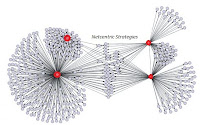
I was invited to spend time on
SAP's rain soaked campus in
Palo Alto, California last week and met with people from several different groups to discuss mobile computing, mobile strategies and how mobile start-ups can best partner with SAP. This article reviews some of those discussions.
One of the first points to understand is that SAP LOVES mobility. In December SAP announced that one of their key focuses for 2010 would be mobility. I wrote about
SAP's announcement
here in December. What this means is SAP is looking for partnerships with mobile software companies that will extend the reach of their core software to more users. Let's talk about what that means.
SAP is one of the largest software companies in the world and traditionally they have focused on selling to the largest global companies. They have been successful in this strategy, but even with their successes, they still have relatively few users in each of their customers' operations. Some estimates have it at about 445 users per customer on average. That may sound like a lot of users, but many of these companies may have tens of thousands of employees.
SAP's strategy now is to look for solutions and partnerships that will expand the value of their core systems to employees within their customers' operations that are not traditionally SAP users. This is a key point for mobile software companies to understand.
If you imagine the glassy surface of a pond and how it looks when a rock is thrown into it. The rock lands with a splash and a series of circles form. The inner circle is the smallest and represents
SAP's current users within an enterprise. Each surrounding circle is bigger and covers a wider area and represents more possible users. These are the circles SAP wants to move into and where they want to add value. If you, as a mobile software company, can help them do that, then they are interested.
Let's explore how to expand the circles. What do we need to know?
- Who needs access to SAP system data, but is not sitting in a cubicle with SAP access today?
- Who collects SAP system data that is not currently a SAP user? They may be collecting data on paper forms today and re-keying the data into SAP at another time.
- Who are the mobile employees at a SAP customer? What are their roles and what data do they need to view and collect while on the road?
- What supervisors need access to SAP anywhere and at anytime?
- What managers need SAP management reports while on the road?
- Is there SAP system data that needs to be shared externally with extended multi-enterprise supply chains via mobile devices? You don't want your supply chain partners to view all of your system data, but are there alerts, updates, reports, etc., that should be shared via mobile devices?
- Should the logistics department have mobile "proof-of-delivery" applications in the hands of their truck drivers?
- Should plant maintenance managers have mobile inspection applications that feed SAP?
- Should service technicians be using mobile service tickets that feed SAP or an SAP partner's work order management system?
- One SAP customer has over 600 food processing inspectors worldwide. This inspection data needed to be collected and stored centrally. While this may not be a core SAP application, it shows that SAP customers often have a large number of mobile data collection requirements that can be turned into management reports and provided to traveling managers.
All of these applications are adding new users to the SAP family. If you can add new users to the SAP family, then you will have the ear of the entire SAP sales organization.
Part 2 of this series can be found here, Part 3 here and part 4.
If you would like to discuss this subject in more detail please email me here. If you would like to follow my discussions and be alerted to new Mobile Strategies for Businesses' articles, then you can add me to your RSS reader or twitter account @krbenedict.
***********************************************
Author Kevin Benedict
Independent Mobility Consultant, Wireless Industry Analyst and Marketing Consultant
www.linkedin.com/in/kevinbenedicttwitter: @
krbenedicthttp://kevinbenedict.ulitzer.com/http://mobileenterprisestrategies.blogspot.com/***********************************************


